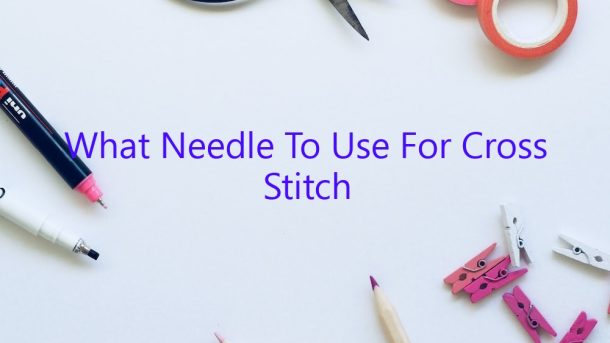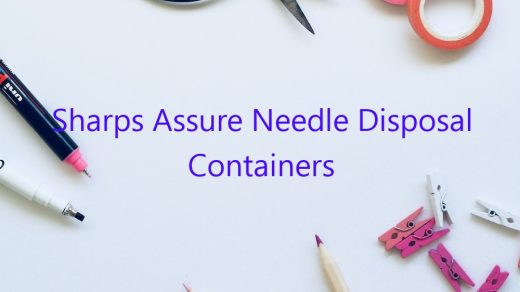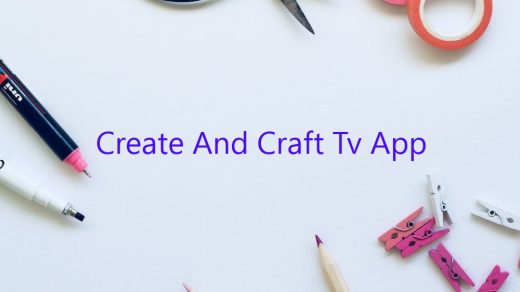When it comes to cross stitch, there are a variety of different types of needles that can be used. The most popular choice for cross stitching is a tapestry needle. This needle has a blunt end and a large eye. It is perfect for stitching through multiple pieces of fabric.
Another option for cross stitching is a sharp needle. This type of needle has a sharp point and a small eye. It is ideal for stitching through a single layer of fabric.
It is important to choose the right needle for the type of fabric that is being used. A blunt needle should be used with thick fabric, while a sharp needle should be used with thin fabric.
Contents
- 1 What size needle do I need for 14 count Aida?
- 2 How do I know my cross stitch needle size?
- 3 Are embroidery needles different from cross stitch needles?
- 4 Is a tapestry needle the same as a cross stitch needle?
- 5 Is 14 or 16 count Aida bigger?
- 6 How many threads do I use on 14 count Aida?
- 7 How many strands do you use for cross stitch?
What size needle do I need for 14 count Aida?
When it comes to cross stitching, you need to use the right size needle in order to complete your project correctly. So, what size needle do you need for 14 count Aida?
In general, a size 24 needle is recommended for 14 count Aida. However, you may find that you need a different size needle in order to complete your project correctly. If the stitches are too tight, try using a size 26 needle. If the stitches are too loose, try using a size 22 needle.
It’s important to use the correct size needle in order to avoid mistakes and frustration while cross stitching. So, be sure to take the time to find the right needle for your project and material.
How do I know my cross stitch needle size?
When it comes to cross stitching, there’s a lot of different supplies that you need in order to get started. Of all the supplies you need, the needle might be the most important. In order to get the perfect finished project, it’s important to use the right size needle. So, how do you know which needle size to use?
There are a few things you need to take into account when choosing the right needle size. The first is the weight of the fabric that you’re using. The thicker the fabric, the bigger the needle size you’ll need. The second is the size of the stitches that you’re making. The smaller the stitches, the smaller the needle size you’ll need.
There are a few ways to find the right needle size. One is to look at the package the needle came in. The size will be printed on the package. Another way to find the size is to measure the needle. To do this, use a ruler to measure the thickness of the needle from one end to the other. The size of the needle is measured in millimeters, so you’ll need to convert the measurement to millimeters if you’re using a ruler that measures in inches. Once you have the measurement in millimeters, you can look it up on a chart to find the corresponding needle size.
If you’re not sure which needle size to use, it’s always best to start with the size that is recommended on the fabric that you’re using. You can always make the stitches smaller or bigger by adjusting the tension of the fabric as you stitch.
Are embroidery needles different from cross stitch needles?
Are embroidery needles different from cross stitch needles?
The short answer is yes, embroidery needles are different from cross stitch needles.
Embroidery needles have a longer shaft than cross stitch needles, and the eye is also larger. This is because embroidery needles are generally used with thicker thread than cross stitch needles.
Embroidery needles also have a sharper point than cross stitch needles, which is necessary for piercing through the fabric.
If you are new to embroidery, it is best to start out with an embroidery needle, as they are specifically designed for the task.
Is a tapestry needle the same as a cross stitch needle?
When it comes to needlework, there are many different types of needles that can be used for different projects. Two of the most common types of needles are tapestry needles and cross stitch needles. So, is a tapestry needle the same as a cross stitch needle?
The short answer is no. Tapestry needles are larger than cross stitch needles and have a blunt end. They are typically used for stitching through multiple layers of fabric, such as in tapestry projects. Cross stitch needles are smaller and have a sharp point. They are typically used for stitching on one layer of fabric, such as in cross stitch projects.
However, there is some overlap between the two types of needles. For example, a tapestry needle can be used for cross stitch projects, and a cross stitch needle can be used for some types of tapestry projects. It all depends on the project and the type of needle that is best suited for that project.
Is 14 or 16 count Aida bigger?
Aida fabric is a type of cloth that is commonly used for cross-stitch. It is available in a variety of different counts, which refers to the number of stitches per inch. So, is 14 or 16 count Aida bigger?
The answer to this question depends on how you plan to use the Aida fabric. If you are looking for a fabric that will result in a larger finished project, then 16 count Aida is a better option. However, if you are looking for a fabric that will produce a smaller project, then 14 count Aida is a better choice.
How many threads do I use on 14 count Aida?
When stitching on 14 count Aida, how many threads should you use? This question can be difficult to answer without knowing the specific project you are working on. However, a general rule of thumb is that for smaller projects, use 2-3 threads, and for larger projects, use 4-6 threads.
If you are stitching a small project, such as a bookmark, you can use 2 threads to create a nice, even stitch. If you are stitching a larger project, such as a pillow, you might want to use 4 threads to create a more robust stitch.
Ultimately, the number of threads you use on 14 count Aida will depend on the specific project you are working on. So, be sure to consult the project’s instructions to determine the right number of threads to use.
How many strands do you use for cross stitch?
How many strands do you use for cross stitch?
This is a question that a lot of people new to cross stitching have, and the answer can vary depending on the project you are working on.
For most cross stitch projects, you will use two strands of floss. This is the most common number of strands to use, as it gives a good balance of durability and coverage.
However, there are some projects that will require you to use more strands. For instance, if you are stitching a very detailed design with a lot of colors, you may need to use four or even six strands to get the best results.
If you are not sure how many strands to use, it is always best to start with two and then add more if needed. This will help to prevent your project from becoming too bulky or heavy.




